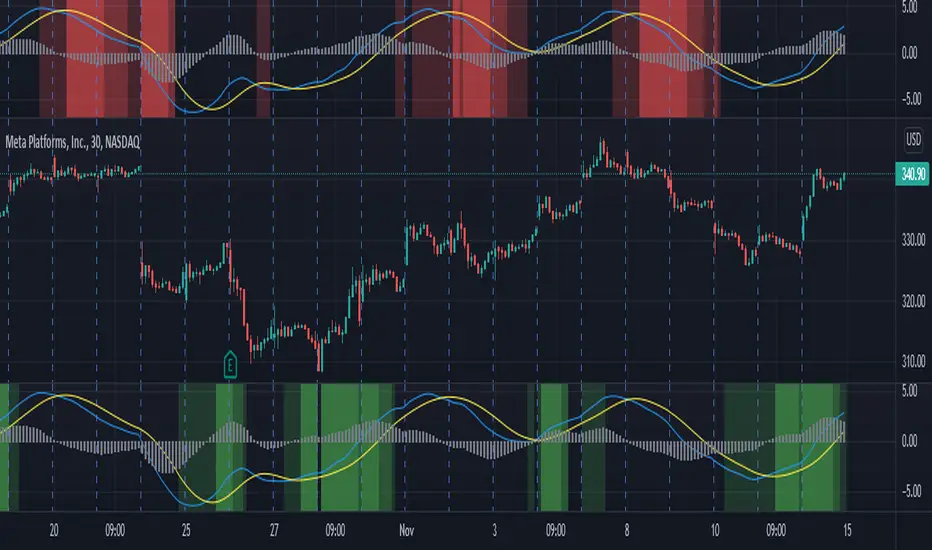MomentumSignals

Contains utilities varying algorithms for detecting key changes in momentum. Note: Momentum is not velocity and should be used in conjunction with other indicators. A change in momentum does not mean a reversal of velocity or trend.
simple(primary, secondary, len) Compares two series for changes in momentum to derive signal values.
Parameters:
primary: The primary series (typically a moving average) to look for changes in momentum.
secondary: The secondary series (typically derived moving average of the primary) to use as a comparison value.
len: The number of bars to measure the change in momentum.
filtered(primary, secondary, len, stdlen, stdMultiple) Compares two series for changes in momentum to derive signal values. Uses statistics to filter out changes in momentum.
Parameters:
primary: The primary series (typically a moving average) to look for changes in momentum.
secondary: The secondary series (typically derived moving average of the primary) to use as a comparison value.
len: The number of bars to measure the change in momentum.
stdlen: The number of bars to measure the change in momentum for filtering.
stdMultiple: The multiple of the change in momentum to use before reversiing.
special(primary, secondary, stdlen, stdMultiple) Compares two series for changes in momentum to derive signal values. Uses statistics to filter out changes in momentum. Does not signal when likely overbought or oversold.
Parameters:
primary: The primary series (typically a moving average) to look for changes in momentum.
secondary: The secondary series (typically derived moving average of the primary) to use as a comparison value.
stdlen: The number of bars to measure the change in momentum for filtering.
stdMultiple: The multiple of the change in momentum to use before reversiing.
Added:
stochRSI(fast, fast, rsiLen, stochLen, src, kmode, upper, lower) Returns a signal value representing the stage of where the RSI is in its cycle.
Parameters:
fast: The length to average the stochastic.
fast: The length to smooth out K and produce D.
rsiLen: The length of the RSI.
stochLen: The length of stochastic.
src: The series to measure from. Default is 'close'.
kmode: The type of moving average to generate. Values allowed are: SMA, EMA, WMA, VWMA and VAWMA.
upper: The upper band of the range.
lower: The lower band of the range.
Returns: [K, D]
+1 oversold and rising
+2 rising above lower boundary
+3 rising above mid
+4 overbought
-1 overbought and falling
-2 falling above mid
-3 falling below upper boundary
-4 oversold
Updated:
stochRSI(smoothK, smoothD, rsiLen, stochLen, src, kmode, upper, lower) Returns a signal value representing the stage of where the RSI is in its cycle.
Parameters:
smoothK: The length to average the stochastic.
smoothD: The length to smooth out K and produce D.
rsiLen: The length of the RSI.
stochLen: The length of stochastic.
src: The series to measure from. Default is 'close'.
kmode: The type of moving average to generate. Values allowed are: SMA, EMA, WMA, VWMA and VAWMA.
upper: The upper band of the range.
lower: The lower band of the range.
Returns: [signal, stage] Where stage is: +1 is oversold and rising, +2 rising above lower bound but less than mid. +3 rising above mid. +4 is overbought. Negative numbers are the reverse.
Pine Bibliothek
Ganz im Sinne von TradingView hat dieser Autor seinen/ihren Pine Code als Open-Source-Bibliothek veröffentlicht. Auf diese Weise können nun auch andere Pine-Programmierer aus unserer Community den Code verwenden. Vielen Dank an den Autor! Sie können diese Bibliothek privat oder in anderen Open-Source-Veröffentlichungen verwenden. Die Nutzung dieses Codes in einer Veröffentlichung wird in unseren Hausregeln reguliert.
Haftungsausschluss
Pine Bibliothek
Ganz im Sinne von TradingView hat dieser Autor seinen/ihren Pine Code als Open-Source-Bibliothek veröffentlicht. Auf diese Weise können nun auch andere Pine-Programmierer aus unserer Community den Code verwenden. Vielen Dank an den Autor! Sie können diese Bibliothek privat oder in anderen Open-Source-Veröffentlichungen verwenden. Die Nutzung dieses Codes in einer Veröffentlichung wird in unseren Hausregeln reguliert.